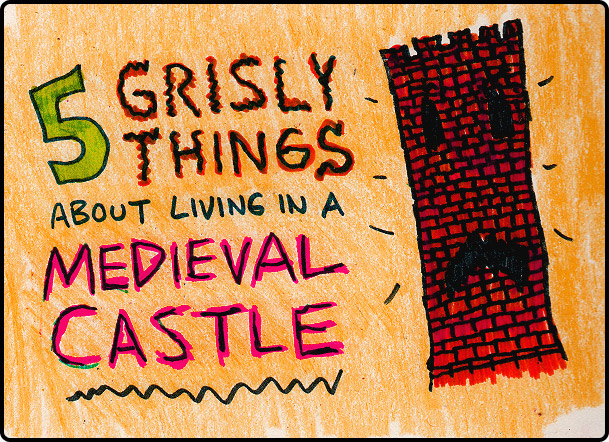I’m obsessed with medieval castles, but they were scary. Aside from the lack of every conceivable convenience that we now take for granted, life was just so much more brutal during the Middle Ages. Yeah, duh, but I don’t just mean that in an “enemy invaders with big swords” sort of way. Daily life was brutal.
Maybe the people who lived during those times didn’t consider it that way, but they didn’t know any better. Let’s put it this way: I’m interested in many times-and-places in history, and I sometimes dream about using a time machine to spend just one single day experiencing them in person. Not so with medieval castles. I know I wouldn’t last an hour.
To illustrate why, I’ve assembled five grisly facts about living in a medieval castle, pulled from various books. Maybe none of these things would be dealbreakers for you, but they only hint at the fright-filled lives of castle dwellers.
As an added bonus, I saw fit to draw and color each of these atrocities, so while I cannot claim to be the finder of these facts, I can at least claim to be the guy who drew a giant louse with a crown on its ass.
#1: Severed Head Scare Tactics!
You’ve seen plenty of sieges in movies, and discounting sci-fi/fantasy flicks, the violence was not overstated. Still, it wasn’t as if every siege ended with a huge, bloody battle. Some sieges bordered on amicable, with the defenders and invaders sharing a kind of loose agreement that they would only take baby steps into more violent territory. Actually, some sieges ended with the invaders simply “starving out” a castle!
Of course, it wasn’t always that way, and if a siege became particularly heated, the participants were not above pulling some wacky shit. For example, the invaders might use a trebuchet (basically a catapult) to launch severed human heads into the castle. Trebuchets were normally used to hurl brick-demolishing rocks, but if the bigger aim was to squash enemy morale, a bloody head worked wonders. Keep in mind, those heads would’ve belonged to the castle’s own soldiers!
#2: Ducking Stool!
Even during “happy” times, there were so many ways to get into trouble. If you lived in a medieval castle, you had to know the rules. There were rules for everything. Rules about finance and taxes, rules about work and leisure, rules about who could do what on what day, rules about who could eat what and where – it’s enough to make you dizzy.
If you were clumsy, stupid or just quietly defiant, you were going to get into trouble. Your offense may not have warranted a “permanent” punishment, but there were plenty of ways to deal with smaller crimes. One method was the ducking stool.
Castle moats were used for more than just defense. People also used them for fishing, and for punishing people who tried to fish when they weren’t supposed to.
A ducking stool was a great big chair. The offender (generally female) was strapped in, and then dunked into the gross moat water, several times in succession. This was rarely meant to kill anyone, but it doesn’t sound like much fun.
Actually, it was worse than it sounds, because no matter what grimaces they wore, everyone around you viewed these weird punishments as a kind of entertainment. So, while you were being dunked, you had an audience. You couldn’t go home and pretend it never happened.
Even the lightest punishments were meant to totally embarrass the accused. Given how the castle’s laws were so easily misused, it’s not hard to imagine that some folks’ only “crimes” were having more important people not like them.
#3: Naughty Knights!
I don’t want to overstate this, but the more I read, the scarier the knights seem. And I mean, the knights on your own side. They were not at the very top of castle society, but there were plenty of people under them. Bluntly put, some knights used their position to be horrible assholes. Think of the biggest bully you know, and throw him a cop uniform. It was a bit like that.
Not everyone who was connected to castle society lived inside the castle, and there are numerous horror stories about how certain knights acted when there weren’t many around to notice. It wasn’t a universal rule, but even with a fraction of the knights being complete dicks, I’d assume that many people just feared them all equally.
#4: Oubilettes!
Most castles had prisons or dungeons. An oubliette is basically a little coffin/cell/cave thing carved into the back or bottom of one, where particularly hated prisoners could be tossed in and forgotten about. (Fittingly, “oubliette” comes from the French word oublier, meaning “to forget.”)
Generally, you were put there to die there, and there was no getting out. Given some of the other options, I guess starving to death in a rat-infested hole wasn’t the worst way to go. It’s still way creepy to think that on any given day, a castle had people rotting in its figurative basement. Must’ve been great for ghost stories, though.
#5: Lice, Lice, Everywhere!
Everyone had lice. Water was precious – especially during sieges – and baths were a luxury for most. Lice were such a way of life that people treated appointments to be deloused much in the same way people treat appointments for haircuts today. Maybe I’m exaggerating, but yeah, if you lived in a castle, you had lice.
Bugs were everywhere, man. All kinds of them. On you, in your room, in your food. The castle was no place for entomophobics. I know this doesn’t sound like much when compared to the “showier” torments, but just imagine it. Say you’re getting along just fine, being whatever you are in the castle. You’re making a living, you’re not sick, and nobody wants to tie you to a chair and dunk you underwater. Even if you’ve managed that, you still have lice.
Partial bibliography: Life in a Medieval Castle by Joseph Geis, and Stephen Biesty’s Castles.













